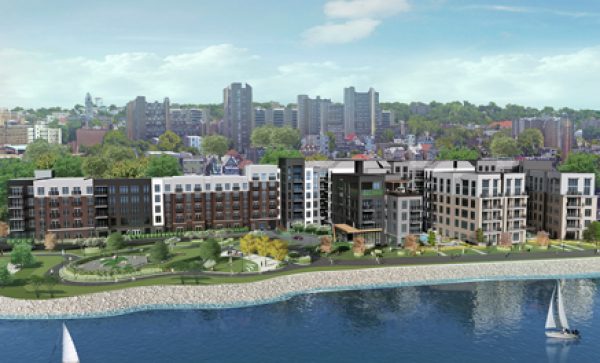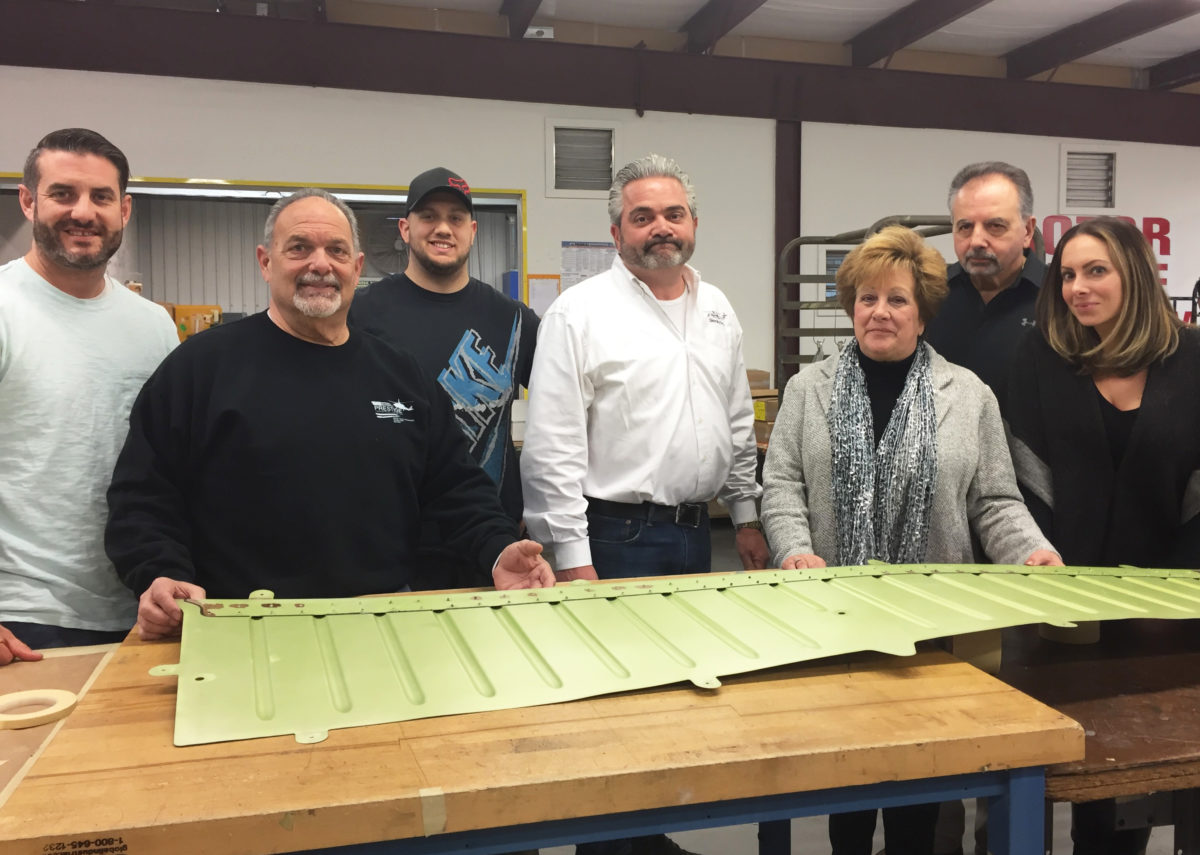Sound infrastructure, connectivity and culture. Those are just a few of the investments Westchester’s cities can make to become “go-to” communities in the region, according to area developers.
“We want to do business in towns and cities that want us to be there. And they want to see their town or their city grow and develop kind of like a Brooklyn or a Hoboken,” said Anthony Vulpi, vice president of development for Mill Creek Residential Northeast Division, which is in the midst of constructing Modera Hudson Riverfront, a 324-unit apartment complex in Yonkers.
“Yonkers definitely fit that bill,” he said.
The 572,500-square-foot residential community at 20 Water Grant St. along the Yonkers waterfront will feature studio, one- and two-bedroom apartments and more than 15,000 square feet of amenity space. The development will also feature a rooftop deck, pool and courtyards. Vulpi said the first rental units will be available by early 2018.

Formerly known as Palisades Point on the Hudson River, the property was previously slated for redevelopment as part of the city”™s public-private partnership with master developer Struever Fidelco Cappelli L.L.C. In 2013, the Yonkers City Council approved amendments to SFC”™s leases at Palisades Point to allow SFC”™s only remaining partner in Yonkers, New Jersey-based Fidelco Realty Group, to proceed with development plans on the waterfront site. Mill Creek Residential bought the leasehold interest from Fidelco and started construction on the property in 2016.
“What drew us to Yonkers is pretty self-explanatory,” Vulpi said. “You”™ve got a great little downtown area, good restaurants, it”™s culturally diverse. It”™s got the train station two blocks from our site, and on top of that, we”™re right on the waterfront, so it was really a perfect combination of things.”
Dallas-based Mill Creek Residential has more than 20,000 apartment homes nationwide, including complexes in Morristown and Jersey City in New Jersey and Mineola on Long Island. Though Mill Creek Residential has not submitted any plans for other projects in Westchester, Vulpi said the company is keeping an eye on the county”™s growing market.
“We”™d love to expand in Yonkers, New Rochelle, White Plains,” Vulpi said. “They”™re all definitely on our list.”
Vulpi is not alone in his optimism regarding the Westchester marketplace. He was one of four panelists included in The Business Council of Westchester”™s “Reimagining Our Downtowns: The Residential Model” event. Held at Tappan Hill in Tarrytown on March 7, the discussion focused on the transforming urban landscape of Westchester’s cities and the boom in the residential market.
In Yonkers, more than 5,000 residential units have been approved or are under development, and there are 4,000 multifamily residential units either under construction or in the pipeline in White Plains. New Rochelle has 1,000 apartments approved or under construction and another 2,000 in the planning stages. More than 8,000 units are making their way through the planning and development stages in Mount Vernon.
“The way people live, work and play has changed over the last couple decades,” said Seth Pinsky, executive vice president of Long Island-based RXR Realty, which broke ground on a $120 million, 28-story mixed-use building in downtown New Rochelle in November. “There”™s an increase in the desirability for walkable, diverse neighborhoods with character and transit connectivity.”
Pinsky said this shift presented suburban areas with a challenge in retaining their population base, forcing Westchester’s cities to change the way they view residential construction.
“Today there”™s a willingness in the suburbs to look at a different type of development than perhaps people were willing to explore in the past,” Pinsky said.
Martin Berger, managing principal of Saber Real Estate Advisors in Armonk, cited lower interest rates as another reason for the increase in residential development in Westchester.
“Banks have rushed to fill the residential developers’ pockets,” said Berger, whose firm plans to develop The Collection in White Plains, a mixed-use project on the former Key Ford site on Westchester Avenue. “It”™s a question of how long it will last.”
Panelist Joseph Apicella, managing director of Pelham-based MacQuesten Development LLC, which is nearing completion of an 11-story, 81-unit affordable housing complex The Modern in Mount Vernon, added that by funding infrastructure improvements, municipalities can “create an environment for local and regional developers to want to come into a community.”
Vulpi cited the daylighting of the Saw Mill River as a “crucial” element to the revitalization of downtown Yonkers and his company”™s ultimate decision to develop in the city.
“That”™s what we want to see as developers, so when we come in, our residents are going to have those kind of things at their disposal,” he said.
Pinsky, whose RXR Realty is also developing Larkin Plaza, a $190 million mixed-use development project in downtown Yonkers, echoed Vulpi”™s sentiments.
“Without a doubt, the investments that Yonkers made in their downtown, not just with the daylighting, but with the board of education and library building, with their renovations they made in the trails along the waterfront, absolutely were a draw to us,” he said.
Panelists agreed that for a downtown to be successful, cities need to offer their residents a unique experience.
“No one is going to move into a Westchester city only for an apartment unit. They want culture, and they want it at their doorstep,” Berger said.
Pinsky said these large-scale development projects should offer hope to Westchester County.
“The fact that there are so many interesting cities where so much is happening here is really positive for the future,” he said. “Not just for the population of Westchester, but for the economy of Westchester as well.”
While many developers realize the importance of attracting the millennial and empty nester demographics, panelists also noted another demographic populating these large residential complexes: the recently divorced.
“They”™re looking for a new life, but they want to stay close to the kids and stay close to their community,” Pinsky said.
While developers are keeping an eye on the sharp uptick in residential units the market has seen in recent years, panelists said they were not overly concerned with overcrowding the market.
“I think anyone who says it”™s a slam dunk is underestimating the market,” Pinsky said. “But Westchester needs these units. There is an enormous amount of pent up demand.”
Still, Pinsky said that he foresees opportunities for the construction of for-sale condominiums in Westchester’s downtowns in the future.
“There”™s no reason to believe that as these downtowns become more desirable,” he said, “that people will want to not only rent there, but also to own and really put down roots in these communities.”
Other developers are not so certain.
“We built a lot of for-sale condominiums,” said Apicella, a former longtime executive at Cappelli Enterprises, “and then there was 2008, and people like us were like, ”˜What do we do now? How are we going to pay common charges on all those unsold condos that are sitting there?”™” The recession had an impact on both the capital markets and developers, he said. “The costs are very, very high, and people are not willing to pay that price, that premium necessarily, yet. The profit is just not there.”
“I think the word ‘traumatized’ says it best,” said Berger, who estimated his firm had around 2,000 residential units for sale at the time of the market crash. “There”™s an 88-degree golf wedge in the corner of my office, and anyone has permission to plant it in me if I propose condominium development.”






















Comments 1